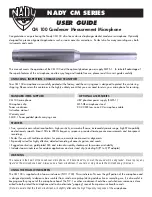
[40]
APPENDIX G – WAVEWARE INTERFACE SPECIFICATIONS
This appendix is included for those who want to develop their own paging control software or add an
interface for the WaveWare v9E Paging Encoder to their existing software applications.
The difference between WaveWare and TAP protocols is that the WaveWare protocol is
a dedicated
connection that doesn’t require a login process and it assumes that the host device maintains a database
of all paging parameters
associated with a pager, including capcode, encoding method, and RF data rate.
The WaveWare Interface supports paging message blocks up to 512 characters in length while the TAP
interface supports paging message blocks up to 256 characters in length, group paging, and timed messaging.
Each protocol has its advantages and disadvantages, but both accomplish the process of causing POCSAG
encoded paging messages to be delivered to local area pagers.
THE COMMANDS FOR SERIAL PORT PAGING USING THE WAVEWARE PAGING PROTOCOL INCLUDE:
PAGING MESSAGE
SETUP COMMAND
STATUS CHECK
PAGING MESSAGE FORMAT
THE PAGING MESSAGE COMMAND IS FORMATTED AS FOLLOWS:
FORMAT 1:
<SOH>TBC...C<STX>XXXX...XXX<ETX><EOT>
FORMAT 2:
<SOH>T,B,C...C,<STX>XXXX...XXX<ETX><EOT><CR><LF>
Note:
The commas, the <CR> character, and the <LF> character are optional in the Paging Message
command. They are used for appearance purposes to separate subparts of the command string and for
formatting the echoed output while troubleshooting the system.
<SOH>
– Used to mark the start of a message. This character resets the paging system and can be used to
abort an incomplete paging command at any point prior to transmission.















































